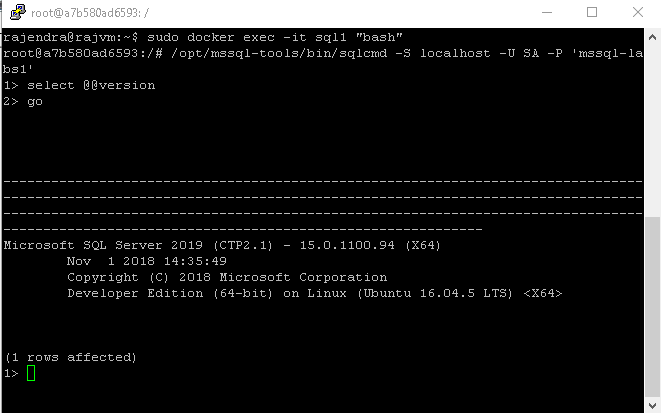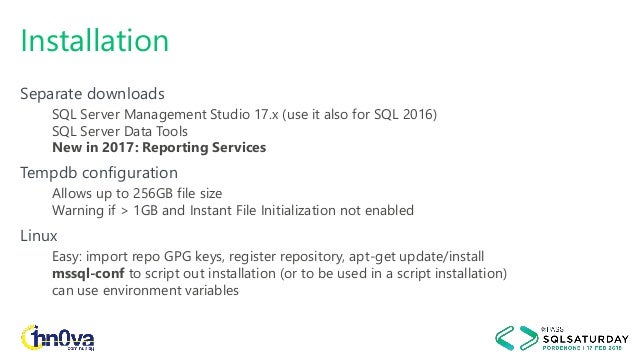
Get Sqlcmd For Mac Windows 7
Sql For Mac; We are excited to announce that SQL Operations Studio is now available in preview. SQL Operations Studio is a free, light-weight tool for modern database development and operations for SQL Server on Windows, Linux and Docker, Azure SQL Database and Azure SQL Data Warehouse on Windows, Mac or Linux machines. Torrent karma motif software. Digimon movie sub indo lengkap. In it, I demonstrate the process of setting up SQL Server on Linux, use the sqlcmd command line tool, dive deeper into Docker, and connect instances to and from other machines on the network. Or, for more information on how to use SQL Server now that you're up and running, check out Learn SQL Server 2017. So I’m busy working on my new dbaSecurityScan module, busily trying to write all the pester tests for the appveyor pipeline Part of the testing for the module involves building a number of test scenarios, each of which of which needs a database spinning up for it. On the Windows builds, that’s nice and easy. I previously explained how to install SQL Server on a Mac via a Docker container. When I wrote that, SQL Server 2017 was the latest version of SQL Server, and it had just been made available for Linux and Docker (which means that you can also install it on MacOS systems). We are excited to announce the availability of the preview for SQL Server Command Line Tools (sqlcmd and bcp) on Mac OS. The sqlcmd utility is a command-line tool that lets you submit T-SQL statements or batches to local and remote instances of SQL Server. The utility is extremely useful for repetitive database tasks such as batch processing.



| § install |
| 1. install Homebrew https://docs.brew.sh/Installation.html |
| 2. install Docker |
| $ brew cask install docker |
| this places the Docker.app in the Applications folder, and can be launched directly to start the service |
| 3. install mssql per the instructions https://docs.microsoft.com/en-us/sql/linux/quickstart-install-connect-docker |
| $ sudo docker pull microsoft/mssql-server-linux:2017-latest |
| 4. run the image, check the status |
| $ sudo docker run -e 'ACCEPT_EULA=Y' -e 'MSSQL_PID=Developer' -e 'MSSQL_SA_PASSWORD=<password>' -p 1433:1433 --name mssql0 -d microsoft/mssql-server-linux:2017-latest |
| $ docker ps -a |
| $ netstat -an | grep LISTEN |
| $ sudo lsof -nPi -sTCP:LISTEN | grep 1433 |
| 5. install sql-cli and connect https://www.npmjs.com/package/sql-cli |
| $ npm install -g sql-cli |
| $ mssql -u sa -p <password> |
| or possibly something like |
| $ mssql -s <host> -u <username@host> -p <password> -d <database> -e |
| Connecting..Enter '.help' for usage hints. |
| mssql> .help |
| § copy database |
| 1. create backup on remote host |
| $ sqlcmd -H localhost -U SA -P <password> -Q 'BACKUP DATABASE [<database>] TO DISK = N'<filename>' WITH NOFORMAT, NOINIT, NAME = '<name>', SKIP, NOREWIND, NOUNLOAD, STATS = 10' |
| $ sudo mv /var/opt/mssql/data/<filename> ~/ |
| 2. copy backup to local container directory 'backup' |
| $ scp <user@host>:</path/to/filename> ~/ |
| $ sudo docker exec -it mssql0 mkdir /var/opt/mssql/backup |
| $ sudo docker cp <filename> mssql0:/var/opt/mssql/backup |
| 3. restore from backup |
| $ sudo docker exec -it mssql0 /opt/mssql-tools/bin/sqlcmd -S localhost -U SA -P '<password>' -Q 'RESTORE FILELISTONLY FROM DISK = '/var/opt/mssql/backup/<filename>' | tr -s ' ' | cut -d ' ' -f 1-2 |
| LogicalName PhysicalName |
| ------------------------ |
| <database> /var/opt/mssql/data/<database.mdf> |
| ..multiple logical and physical names: for each add a MOVE logicalName TO physicalName entry like: |
| $ sudo docker exec -it mssql0 /opt/mssql-tools/bin/sqlcmd -S localhost -U SA -P '<password>' -Q 'RESTORE DATABASE <database> FROM DISK = '/var/opt/mssql/backup/<filename>' WITH MOVE '<logicalName1>' TO '<physicalName1>', MOVE '<logicalName2 /var/opt/..mdf>' TO '<physicalName2 /var/opt/..ldf>' |
| Processed.. |
| RESTORE DATABASE successfully processed.. |
| 4. make queries |
| $ sudo docker exec -it mssql0 /opt/mssql-tools/bin/sqlcmd -S localhost -U SA -P '<password>' -Q 'SELECT Name FROM sys.Databases' |
| § tasks |
| 0. change master password |
| > ALTER LOGIN SA WITH PASSWORD='<password>' |
| 1. setup readonly user with sql; in my case I either did something wrong or had a confused preexisting/restored user and to fix I removed the user (on both sys and db: drop user <username>) and recreated. |
| > create login <username> with password='<password>' |
| > create user <username> from login <username> |
| > grant connect, select, execute to <username> |
| > use <database> |
| > create user <username> from login <username> |
| > grant connect, select, execute to <username> |
| § more info, links |
| * more Docker |
| https://docs.docker.com/get-started/ |
| https://docs.docker.com/docker-for-mac/ |
| * helpful |
| http://database.guide/how-to-install-sql-server-on-a-mac/ |
| https://medium.com/@reverentgeek/sql-server-running-on-a-mac-3efafda48861 |
| https://docs.microsoft.com/en-us/sql/linux/sql-server-linux-backup-and-restore-database |
| https://docs.microsoft.com/en-us/sql/relational-databases/databases/copy-databases-to-other-servers |
| https://docs.microsoft.com/en-us/sql/linux/tutorial-restore-backup-in-sql-server-container |
| https://docs.microsoft.com/en-us/sql/tools/sqlcmd-utility |
Get Sqlcmd For Mac Shortcut




